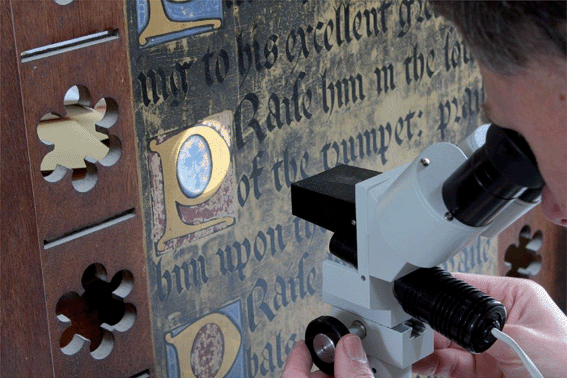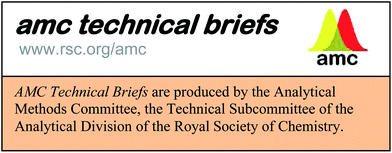Heritage Science – an introduction
Analytical Methods Committee, AMCTB No 66
First published on 23rd February 2015
Abstract
Heritage Science is a field of study that has emerged within the last 15–20 years. It is principally the scientific study of cultural and historic artefacts to assist their conservation and preservation, to enable public access to our heritage, and for overall collection management. It uses analytical science to identify the composition of objects, to determine how they change and degrade over time, and how conservation treatments affect them. Analytical science is also used to understand anthropological issues and enhance the wider public understanding of heritage.
The emergence of Heritage Science has been heralded by several notable actions. These include the 2006 House of Lords Science and Technology committee report on Science and Heritage, the appearance of journals dedicated to Heritage Science and the establishment of a new Gordon Research Conference on Scientific Methods in Cultural Heritage Research.
The Analytical Methods Committee has now created a new sub-committee for heritage science. This expert group aims to help develop the knowledge of analytical science requirements for those working within the sector. In terms of improving the understanding of analytical methodology this sub-committee has identified the following areas that can be developed:
• Technical briefs that outline the principles of different analytical techniques, or explain how historic artefacts need to be sampled and how to interpret results.
• Greater awareness of the benefits of scientific analysis within conservation.
• Greater understanding of the needs of conservators by scientists.
Challenges
To meet the global challenges of conserving our heritage, researchers from many disciplines have used recent developments in science and technology to bring new understanding to the arts. Analytical instrumentation and methodology have brought new possibilities and discoveries to the study of cultural heritage and permitted a much more detailed understanding of artefacts and how they can change.One of the most important considerations is that historical artefacts are irreplaceable and any damage likely to be caused by scientific investigation has to be considered very carefully. Consequently sampling and certain types of analytical measurement can become a real challenge. Researchers sometimes have to work within quite restricted guidelines so that non-invasive analytical techniques and handheld devices are extremely useful.
Another challenge to those working within the heritage community is the availability of experimental facilities, instrumentation, and expertise to understand and interpret the data produced. Because workers may be knowledgeable in selected techniques and only have access to a limited range of analytical equipment, it is important to create and develop partnerships between institutions that manage heritage artefacts and those that have analytical instruments.
Supporting the Heritage Science community
The Heritage Science community is composed of a wide variety of people with specialist knowledge in different areas. For example, there are conservators with specific understanding of craft skills and restoration practices and there are scientists from many different backgrounds with expert knowledge in material science, chemistry, physics, biophysics etc.In terms of analytical science there is a need to have up-to-date analytical reference standards, which are a requirement for reliable and reproducible results, a need for specific information that will help conservators and scientists apply the most appropriate analytical techniques to use in the study of historical objects, and a need to understand how sampling and statistical analysis can be used to improve the quality and interpretation of data.
Transferring knowledge into practice
While many analytical methods are able to enhance our understanding of heritage artefacts it is essential that this information is propagated outside academic circles. It is important that any knowledge gained is interpreted and well publicised so that it can be used to develop conservation and preservation techniques, engage public audiences and bring awareness of any new understanding of our past.A key to transferring knowledge between the scientific and conservation communities is a dialogue between institutions and researchers. More crucially it is important that scientists comprehend the questions that conservators are seeking to answer, while conservators need an appreciation of the limitations of instruments and an overview of the information that analytical techniques can provide them with.
Public engagement
There is a rapidly growing public interest in history and consequently in the historical artefacts that are a tangible part of our past. It necessarily follows that there is a great number of opportunities for engagement with the public. These might include television and radio broadcasts, public lectures, open days at historical venues when conservation work is being carried out, open laboratories and hands-on activities for schools.Through public engagement of this kind it is possible not only to demonstrate the importance and benefit to society, but also to show the potential for the technologies and knowledge gained to influence other areas of science, the arts, and society. Cross-pollination of ideas is hugely beneficial and any form of public engagement that encourages it should be welcomed.
Lee Gonzalez
This Technical Brief was prepared by the Heritage Science Subcommittee and approved by the Analytical Methods Committee on 09/02/2015
.
Further reading
- http://heritagescienceforum.org.uk/ .
- http://www.heritagesciencejournal.com .
- http://www.heritagescience.ac.uk .
| This journal is © The Royal Society of Chemistry 2015 |



